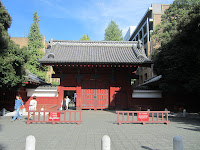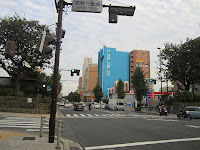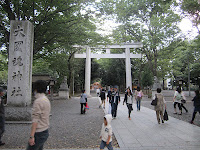2012-10-21
Stadium jumping @ Baji Park: Oct. 21, 2012
It was a nice autumn day (like yesterday). I visited Baji Park (Equestrian Park) to see studio jumping.
I very often visit the park. It was developed for the Olympic Games held in Tokyo in 1964. Various kind og horse events are held here.
Today’s event was a jumping called “Carrot Stakes”, which is open to amateur riders.
Families are enjoying the day.
Nakasendo Walk (3) Omiya- Ageo: Oct. 20, 2012
It was a nice autumn day. I took the 3rd part of my Nakasendo Walk from Omiya, the 4th shukuba station, to Ageo, the 5th.
There are few historical memories or monuments of Nakasendo remain in Omiya. Old Nakasendo has turned to Local (Prefectural) Route 164. It goes northwest through shopping and residential areas.
I dropped in Hikawa Shrine near Omiya station. The shrine worships the god of water. There are more than 200 Hikawa shrines in Kanto region (including Tokyo) and Omiya’s shrine is the head of them. It locate a block from Nakasendo.
It was a season of 7-5-3 festival, which celebrates the girls of 7 years, boys of 5 years and girls of 3 years. I saw many girls and boys in traditional Japanese costumes.
I continued walking. I sometimes found shrines and small sculptures of gods at the side of the road. Tohoku and Joetsu Shinkansen bullet train runs over Nakasendo in northern part of Omiya.
There remain only a few monuments in Ageo, but there were more guide plates of Nakasendo in the city than Omiya or Urawa. It was about 40 kilometers from Nihonbashi.
2012-10-15
Nakasendo Walk (2) Toda- Omiya: Oct 14, 2012

I had the 2nd part of my Nakasendo walk today. It was from Toda (Tokyo-Saitama boader) to Omiya, the 4th shukuba station from Nihonbashi.
I walked northward about 30 minutes and arrived in Warabi, the 2nd station. Atmosphere of Old Nakasendo remained there. I found monuments and guide boards. I dropped in a museum open in a place where old main guest house (honjin)was. The city was celebrating the 400 anniversary of Nakasendo's open (It was developed in early 17th century by Shogun Tokugawa Ieyasu).
Warabi is the smallest city in area in Japan. It is now a satellite city of Tokyo.
I walk through residential areas and arrived in Urawa, the 3rd station. The road has turned to a busy shopping street there.
Walking about an hour from Urawa, I arrived in Saitama New Urban Center (Saitama Shintoshin). It is a huge business-commercial complex open in 2000. Government offices, companies, shopping centers, sports and cultural facilities (including Saitama Super Arena) gather around JR Saitama Shintoshin station.
Urawa and Omiya used to be two big cities in Saitama Prefecture. They merged into Saitama city in 2001. Saitama New Urban Canter lies in the middle of enlarged city.
I arrived in Omiya. It has developed as a treminal of railroad and road traffic. 14 lines (including Shinkansen bullet train) come in and go out of Omiya station.
It was about 30 km from Nihonbashi.
Nakasendo Walk (1) Nihonbashi-Toda: Oct. 13, 2012
Nakasendo is one of 5 major national roads in the Edo era (other 4 are Tokaido, Koshu Kaido, Nikko Kaido and Oshu kaido).
It linked Edo (Tokyo) and Kyoto through mountain area, whereas Tokaido linked the two cities through seaside area. Nakasendo went through Tokyo, Saitama, Gunma, Nagano, Gifu, Shiga, and Kyoto (in current prefecture names). It had 69 shukuba stations.
I started my walk from Nihonbashi toward north-northwest. Department stores gather in the area. Mitsukoshi Department store, which has developed from a famous clothing shop Echigoya established in 1673, had long been a top brand in the country. Bank of Japan's headquarters is also in the area.
I walked through JR Kanda station, Akihabaya electronic shop area and arrived in Kanda Myojin Shrine. It is one of Tokyo's most famous shrines. Many visitors were there. A wedding ceremony was taking place.
I moved to Hongo area, where many Daimyo (local ruler) houses were in the Edo area. Leading Daimyo Maeda family's house had turned into the University of Tokyo and famous "Red Gate" remains.
Ohter historical buildings and monuments also remain in the area. I dropped in Daienji Temple and Enjoji Temple, where a tomb and a monument of Yaoya Ohichi, the most famous arsonist in Japan's history, remain. She placed fire to make an opportunity to meet her one-sided lover. She was later arrested executed in Suzugamori.
 I proceeded to Sugamo, a popular place among elder people. Many visitors gathered in Koganji Temple or Togenuki Jizo. It is believed to call good heath.
I proceeded to Sugamo, a popular place among elder people. Many visitors gathered in Koganji Temple or Togenuki Jizo. It is believed to call good heath.I arrived in Itabashi, the first shukuba station. Itabashi meand a wooden bridge. Current concrete bridge is built as if it is made of wood. The area is now a community-oriented shopping area.
I dropped in Enkiri Enoki, which was believed to bring separation (of man and woman etc.) in the Edo era. Many wish tablets were hanging in the boards. The wishes included “May Mr. A and his wife divorce, then I wish marry him”.
A pair of nettle trees remain at the sides of Nakasendo at Shimura, Itabashi ward. The trees were planted in every 4 kilometers and the places were called Ichiri-zuka (milestone) in the Edo era. National Rout 17 runs on old Nakasendo. Many cars ran through the trees.
I crossed a bridge over Arakawa River,which flows Tokyo-Saitama border. The first city in Saitama Prefecture was Toda. It was about 15 km from Nihonbashi.
Mt. Fuji and beautiful landscapes of Japan from the sky: Oct. 10, 2012
I flow from Haneda (Tokyo International Airport) to Kansai International Airport near Osaka (Sorry, it is not walking).
The weather was nice and I could take good pictures from the plane.
Mt. Fuji had no snow on its top.
Fuji River, Oi River and Tenryu River flow through green mountains and cities.
Kinokawa River flows through Wakayama City into the sea.
2012-10-08
Koshu Kaido Walk (3) Chofu-Fuchu: Oct.9, 2012
Today is a national holiday (Health and Sports day). I took the 3rd part of my Koshu Kaido Walk.
There stood replicas of heroes from “Gegege no Kitaro”, famous manga written by Shigeru Mizuki, in a small street spread from Koshu Kaiso near Chofu railway station. Kitaro is a monster, but he is loved by children as he fights against evils to help people. Mizuki lives in Chofu and is an honorable citizen of the city.
Old Koshu Kaido goes through residential areas in Chofu city. National Rout 20 (new Koshu Kaido) and Keio Dentetsu railroad run along old Koshu Kaido.
A sculpture of Kondo Isamu, a tragic soldier in the late Edo era, was placed in a temple along the street. Kondo served as a head of Shinsen-gumi, a guard organization of the Tokugawa government. He and his organization lost the war with anti-Tokugawa group and he was executed by decapitation. Chofu is a hometown of Kondo and Shinsen-gumi.
I arrived at “Ajinomoto” football stadium in west Chofu. It is a home ground of FC Tokyo football team. The turn-round point of marathon race at Tokyo Olympic Games in 1964 was places in front of the stadium. A monument and a sing board were there.
It was 26 kilometer from Nihonbashi.
Vegetable fields appeared at the side of Koshu Kaido.
I moved to Fuchu, the 5th shukuba station. Historical Okunitama Shrine is in front of Fuchu railway station.
A big shinboku, a tree decorated with religious straw ropes, stood along Koshu Kaido.
There remains Kosatsujo near the shrine. Kosatsujo was a place where official documents were desplayed in the Edo era.
I walked another several kilometers from Fuchu to Nishifu railway station. I found open-air stalls where they sold pears produced in the area. They were sold with "Tamagawa Nashi" brand.
The goal today was about 32 kilometers from Nihonbashi.
2012-10-07
Koshu Kaido Walk (2) Takaido-Chofu: Oct. 7, 2012
I took the 2nd part of Koshu Kaido walk today. It was from Shimotakaid, part of the 2nd shukuba station from Nihonbashi, to Chofu, where the third station was placed.
The 2nd station was called Takaido. Lower and upper Takaido (Kamitakaido and Shimotakaido) stations were used in rotation in the Edo era.
Historical monuments in and along Koshu Kaido (in Tokyo) is not so well preserved as Tokaido.
There remain no inns or shukuba facilities now. I just found a signboard at a place where a milestone was placed.
Koshu Kaido has turned into National Route 20 here. Highways run over the street. Many cars run in both Koshu Kaido and highways.
Automobile dealers, motor bike shops, craft shops, Chinese noodle restaurants and many other shops and restaurants are open along the street.
Old Koshu Kaido separates from and merges with National Route 20. Keyaki or zelkova trees are planted in the sidewalks in some places.
I passed Tokyo’s Suginami ward and Setagaya ward and entered into Chofu city.
Several inns scattered around here (Chofu city) in the Edo era. The place was called Fuda 5 shukuba station. It is 20-24 kilometers from Nihonbashi.
An autumn festival was held at Kokuryo, Chofu city. People played a big Japanese dram there. A tall apartment house was behind the festival site.
Subscribe to:
Posts (Atom)

























.JPG)
.JPG)
.JPG)
















